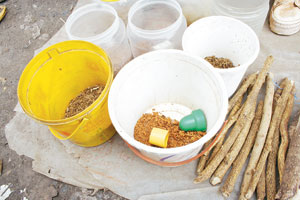By Tricia Wanjala
Until a few weeks ago, when we received government alerts on harmful herbal contraceptives, many of us were not even aware that herbal contraceptives existed.
Stories abound of women who used herbal contraceptives unsuccessfully. Despite the many questions, there are no straightforward answers. |
A lot of women are blindly turning to herbs to prevent pregnancy. Photos: Martin Mukangu/Standard
|
A lot of people wonder if they are genuine products; whether anti-fertility plants really exist; where they can be found; their dangers and why women seek these alternative methods despite the risks involved.
Chemical (hormonal) contraceptives work by preventing ovulation and/ or implantation. If the body does not ovulate no egg is released for fertilisation, thus pregnancy does not take place. A lot of research has been conducted on these methods, since the 1950s when the first birth-control pill was invented. However, many women still complain of serious side effects, including loss of libido, excessive bleeding, weight gain, headaches, varicose veins, delayed fertility upon cessation of the drugs and mood disorders including PMS and depression.
Gertrude Mwazighe,* 34, says: "If you mess around with the body’s chemistry for long, you end up with regrets. When I tried pills and injections I lost a lot of blood to the point I became anaemic, and ballooned terribly. I had to try something different."
But elderly ‘wise women’ in each community will attest to the age-old use of herbs for contraception. Dr Didi Ananda, Chairperson of the Kenyan Society of Homeopaths, says: "In North America, several herbs have been in use, including Black Cohosh. The ancient herb contraceptive, Sylphium, was also used widely in Greece, Persia and Egypt.
Used across the globe
Researcher David Hoffman has tabulated well-known herbs in Mexico, India and China, that contain anti-fertility, spermicidal and anti-implantation properties." In India, more than 250 plants have been found to contain anti-fertility or contraceptive effects. Many of them are listed in ancient Ayurvedic literature. One species of the Hibiscus flower works by preventing implantation. Others delay menstruation and in South America, indigenous women chewed wild carrot seeds daily to prevent conception.
Dr George Karago, a local veterinarian and researcher states: "The herbs used in China, India, Europe and in the Americas are the same as those used in Africa. Because each community refers to them using their unique name, it exposes users to dangers because of the likelihood of misusing the herbs through mixing. Karago says any reputable herbalist will warn against any side effects.
But why aren’t these herbs readily available and why have they not been widely synthesized into preparations such as pills or injections?
Dr Jeniffer Hurwa, acting Director, Department of Traditional Medicine, Kemri, explained: "We are not a government regulatory agency, nor has the government empowered us to do quality control.
We can simply advise. The lack of regulation results in loopholes which are subsequently abused by quacks, such as the recent widely publicised Chinese Doctor who has been dispensing harmful chemical drugs, touting them as herbal contraceptives."
Stay informed. Subscribe to our newsletter
Secrecy and suspicion
So the lack of regulation, fear of intellectual property theft, and the individual apprehension of the herbalists themselves result in an aura of secrecy and suspicion. That legal hurdles stand in the way of registration and regulation does not help matters either. For starters, herbal contraceptives fall under the Ministry of Culture and not the Ministry of Health. A local herbalist complained that, "For a herbal remedy to be registered, it must be tested and each chemical ingredient isolated and catalogued. We have to take them to the Poisons Board for evaluation in a process that costs $1000 (Sh76,000) for each remedy".
Another herbalist cited the age-old tussle between the established pharmaceutical industry and the naturopathic community. He explained: "Some of the pharmaceutical companies fear that once the public become aware of common, cheap, readily available medicinal plants that can be used for various conditions, they will lose revenue."
Herbs that work
In spite of all these challenges, the good news is that there are a few commercially available local herbal anti-fertility products. One is the Eevs herbal contraceptive pill. A monthly dose consists of two pills. One is taken on the eighth day of the cycle and the other, on the 15th day. Paul Habby, the creator of this pill, explained: "It contains a blend of five herbs with different active ingredients, sourced from different African communities, including Cameroon, DRC, Uganda around the Ruwenzori area and the Kikuyu and Kisii communities. It does not prevent ovulation the way chemical contraceptives do, hence it has no side effects. Its works by increasing the elasticity of the membrane that covers the ovum, so the sperm is unable to penetrate and fertilise the egg. The second pill prevents implantation by hardening the uterine lining." Women with religious conviction against abortion opt for herbal alternatives that work .
Clinical studies have placed Eevs’ failure rate at two per cent making it an apparently highly effective product.
Shirley Wangui,* 28, used Eevs and said: "I did not experience any side effects in the first few months of usage. But I stopped because I could not remember the days of my cycle and feared conceiving".
Male contraceptive
The Woman’s Instinct team spoke to several herbalists but majority were reluctant to comment on the topic. One herbalist based in the city centre said, "It is too controversial right now, so until further notice, we are not dispensing herbal contraceptives." Another mentioned that he knows of some herbs used by local traditional communities.
These work by stopping menstruation completely until the woman decides she wants to resume, at which point she simply takes a different herbal combination to bring on the menses.
Neem (Mwarubaini), for example, has been the subject of widespread research in Africa and India. When used correctly, it is nearly 100 per cent effective. It is cheap, readily available and easily reversible with absolutely no side effects. Indeed, several well-documented studies have demonstrated that the Neem plant is a powerful anti-fertility agent for both men and women. For women, it works as a potent spermicide. When inserted prior to intercourse, studies showed that Neem oil killed sperm in the vagina within 30 seconds and was effective for up to five hours.
However, Dr Didi Ananda cautions that Neem oil is best used together with a barrier such as a condom, so that in the event of improper application, pregnancy is still prevented. Research in India has also proven Neem to be a powerful and effective male contraceptive. Neem leaf tablets ingested for one month produced reversible male anti-fertility without affecting sperm production or libido, and when a minute amount was injected into the vas deferens it provided up to eight months of birth control. For some, the drawback with Neem is its pungent odour. Rebeccah Ngugi,* 24, said, "I tried it but it stinks for a week after that. I cannot bring myself to use it again."
The law in waiting
Wendy Akinyi, * 27, said she does not mind the smell because she has no choice. She explained: "I am chronically hypertensive, and using hormonal contraceptives was out of the question as they would have exacerbated the high blood pressure. Also, every time I tried them, I got a thrush, and the doctor warned that I risked getting systemic Candidiasis (thrush), which meant I would have it in my system for life. So the smell was the least of my worries. Now I always keep a bottle of Neem handy."
Meanwhile, a draft Traditional Herbal Medicine and Medicinal Plants Bill (2008) has been prepared by the Attorney General and is awaiting Cabinet approval. In the event that it becomes law, Kenyans will have access to more knowledge on herbal products, which would be regulated to sieve out quacks.
*Names changed to protect identity.
 The Standard Group Plc is a
multi-media organization with investments in media platforms spanning newspaper
print operations, television, radio broadcasting, digital and online services. The
Standard Group is recognized as a leading multi-media house in Kenya with a key
influence in matters of national and international interest.
The Standard Group Plc is a
multi-media organization with investments in media platforms spanning newspaper
print operations, television, radio broadcasting, digital and online services. The
Standard Group is recognized as a leading multi-media house in Kenya with a key
influence in matters of national and international interest.
 The Standard Group Plc is a
multi-media organization with investments in media platforms spanning newspaper
print operations, television, radio broadcasting, digital and online services. The
Standard Group is recognized as a leading multi-media house in Kenya with a key
influence in matters of national and international interest.
The Standard Group Plc is a
multi-media organization with investments in media platforms spanning newspaper
print operations, television, radio broadcasting, digital and online services. The
Standard Group is recognized as a leading multi-media house in Kenya with a key
influence in matters of national and international interest.








